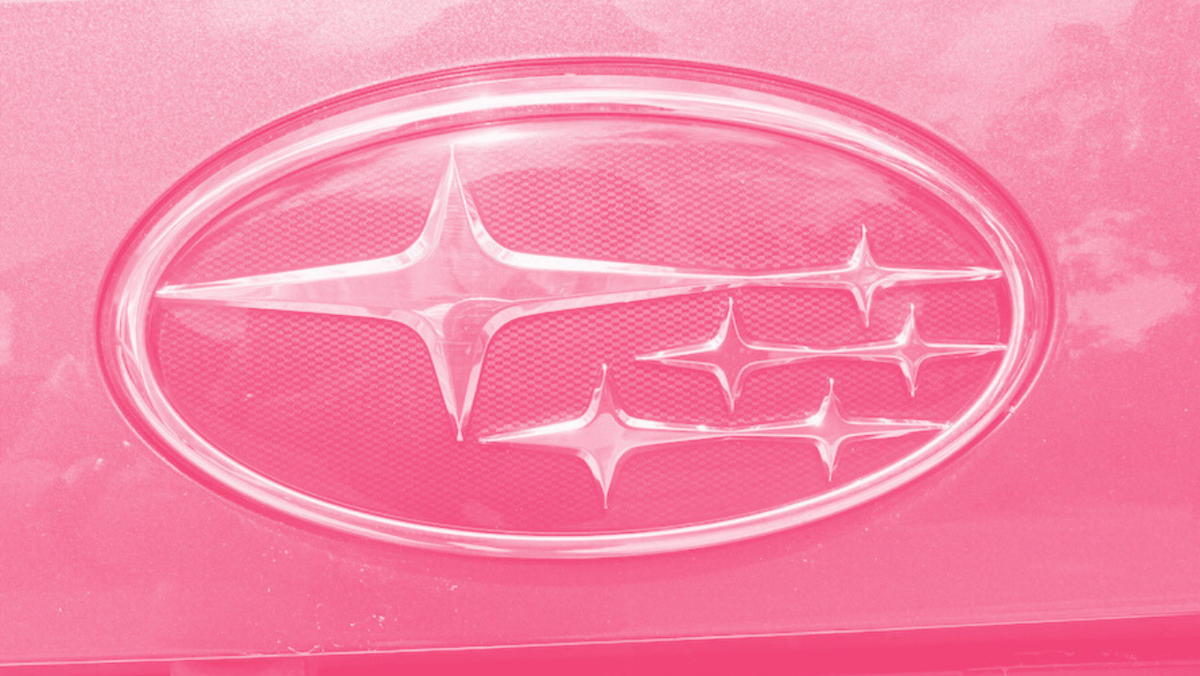Not everyone bursts out of the closet. Some take their time, send subtle signals, test the waters, and — when they feel they’re ready — jump to the head of the parade.
That’s what Subaru did.
In the early ’90s, Subaru began winking at lesbian car buyers. The messages were coded so carefully that they would go over a straight person’s head. But lesbians, and the LGBTQ community as a whole, knew exactly what was going on.
It was like sneaking a game of footsie under the dinner table.
This is part of my Gayskool project:
A new LGBTQ-themed post every day for Pride month.
Subtext Is Everything
Today, the clues will seem obvious, even to many straight people. At the time, though, they were cleverly hidden in plain sight.
Here are a few examples.
She Was a Fast Machine, She Kept Her Motor Clean, She Was the Best Damn Woman That I Ever Seen
First, a quick ad that, depending on your point of view, either pokes fun at or perpetuates lesbian stereotypes.

You’re On The Right Track Baby …
While everyone was embroiled in the nature vs. nurture debate, Subaru coopted one of the key talking points to say four-wheel drive was standard on all vehicles and not a choice. At the time, “Not a choice” was a rallying cry for LGBTQ people — our enemies were adamant that homosexuality was not an innate trait but something that could be unlearned.

Aced It!
Subaru knew what it was doing when it tapped tennis icon Martina Navratilova as its spokesperson.
Straight people, even those aware of her sexuality, would see a top-tier athlete with more hardware than Home Depot (she has nine of those fancy silver dishes from Wimbledon, just for starters) talking about a car company.
But LGBTQ people knew Navratilova as an icon and activist, and her endorsement carried a lot of weight.
This 1990 TV ad features Navratilova and three other athletes: pro golfers Juli Inkster and Meg Mallon and Olympic skier Diann Roffe.
What makes this ad so fiendishly clever is that straight audiences would take it at face value — four athletes poking fun at the “I’m just a girl” trope to tout Subaru’s performance. LGBTQ audiences would also pick up on the fact that lesbians admired all four women.
Artistic License
And now, my absolute favorite ad. It screams lesbian — but only if you know what you’re looking for.
A straight audience would see Subaru touting the versatility of their vehicles — there’s a model for everyone!
LGBTQ people would have immediately picked up on the license plates:
- CAMP OUT: Like in the first example above, camping would have been an activity associated with a lesbian stereotype. Plus, the word “out” makes the message abundantly clear. (Note the rainbow flag on the back bumper: This symbol was much less prevalent and known in the ’90s than today.)
- XENA LVR: Xena: Warrior Princess was a campy TV show with a massive lesbian following. Xena and another character, Gabrielle, were the hottest lesbian couple1 ever to appear in syndication, even though the actors (Lucy Lawless Renee O’Connor) said they were playing it straight, so to speak.2
- P TOWNIE: Provincetown, Massachusetts, is an LGBTQ enclave at the very end of Cape Cod. If you didn’t know that, you’d think Provincetown was just another picturesque seaside beach town. And if you’d never heard of Provincetown to begin with, the license plate would have no meaning.

The Drive to Succeed
Don’t give me credit for figuring any of this out. Many people have reported, researched, and analyzed Subaru’s not-so-secret lesbian strategy:
- NPR: “How Lesbians Helped Save Subaru”
- Priceonomics (via Longreads): “How an Ad Campaign Made Lesbians Fall in Love With Subaru”
- Marketing the Rainbow: Subaru Case Study
The tl;dr is that Subaru wasn’t performing well financially and decided to host focus groups for buyers in cities with strong sales, like Northhampton, Mass., and Portland, Ore.
The focus groups were filled with lesbians. These were out and proud lesbians with money to spend and a penchant for practical cars. Subaru had found its target market. While every other car company was going after straight folks in the suburbs, Subaru was figuring out how to sneak Xena references into ads.3
In the early 2000s, Subaru stopped winking at LGBTQ customers. It was time to make the relationship public. Subaru sponsored events, programs, and even the first LGBTQ satellite radio station. It also contributed to AIDS research and LGBTQ advocacy groups, like the Human Rights Campaign.
From where I sit — which, if I’m in the car, is behind the wheel of a Subaru Forester — Subaru’s efforts have paid off. Subaru is one of those brands that LGBTQ people seem to love and trust. Unlike the pinkwishy-washy companies I identified a few days ago, Subaru has demonstrated true allyship that goes well beyond rainbows and Pride flags. It has spoken our language for 30 years, embraced us publicly for 20 years, and has even used its clout as a major employer to speak against anti-LGBTQ legislation.
The road ahead looks bright for Subaru. And I know a lot of LGBTQ people will come along for the ride.
Footnotes
- If you’re into that kind of thing. ↩︎
- Oh, don’t believe me? Just watch this. And keep in mind that this video is just Part 1 of a series about Xena and Gabrielle. ↩︎
- Subaru also had some ads with coded messages for gay men. For example: “Try me … I’m versatile” and “Nice package!” ↩︎

